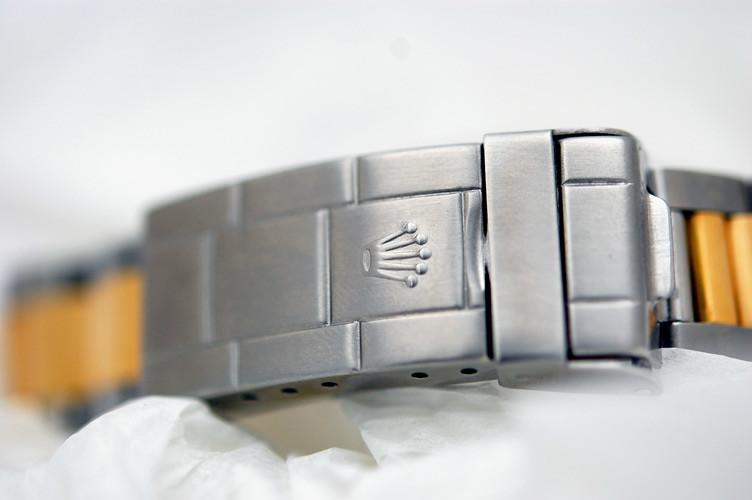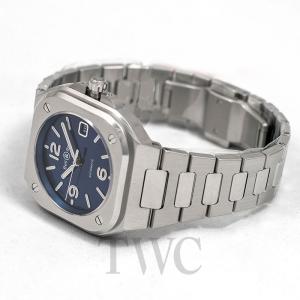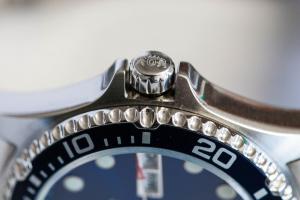Types of Watch Clasps: A Guide to a Watch’s Most Important Security System

As an important part of our daily lives, we wear wristwatches to help us keep track of our time. We go on our everyday routines and tasks with a handy timepiece fitted around our wrists, helping us make sure that we stay punctual and on top of everything.
One of the most integral building blocks of a watch that it cannot work without is the piece that locks it onto our wrists. This particular component is none other than the watch clasp. In this article, we will be taking a closer look at what a watch clasp is, how it functions, and the different types of watch clasps that are most frequently used in timepieces.
What is a Watch Clasp?
A watch clasp is essentially the security system that binds the ends of a timepiece’s bracelet or strap together. Just like all the parts of a timepiece, the watch clasp is a significant element. It plays a huge role in terms of making sure the watch fits and is kept safely on our wrists. Without it, we would not be able to keep any watch secured around our wrists, and having one would be quite pointless.
Now, let us get to know some of the most commonly used types of watch clasps from a few famous watch brands.
Types of Watch Clasps
1. Pin Buckle
One of the most popular types of watch clasps is the pin buckle. We are sure you have encountered this type of traditional watch clasp in many timepieces. This watch clasp goes by several names, so you might be a little confused about what to properly call it. It is also sometimes known as the “tang buckle or the Ardillon buckle.” Regardless, these terms are interchangeable and essentially mean the same thing.
The pin buckle functions similarly to how waist belts are used. A buckle, made mostly from metals like stainless steel, titanium, or in some rare cases, platinum, rests on the shorter end of the strap. A pin, also known as the buckle tongue, is placed right in the centre of this buckle. While wearing the watch, the longer side of the strap, with various adjustment holes, passes through the pin buckle. The pin is then inserted into one of the adjustment holes, allowing it to accommodate wrists of any size. The strap is then secured by the free loops placed just below the pin buckle.
The pin buckle is typically attached to watches with leather, rubber, or nylon straps. One stylish example is the Hamilton Khaki Aviation Ref. H76645540. This Hamilton Khaki Aviation watch shows off a stainless steel pin buckle fixed at the tip of the shorter side of its brown leather strap.
2. Folding Clasp
Just like the pin buckle, the folding clasp is one of the most frequently employed types of watch clasps. This watch clasp variant is most often seen on metal bracelets. Depending on what type of material the bracelet is made from, the folding clasp usually follows its construction as well. As such, it can be made using stainless steel, titanium, platinum, or ceramic.
The folding clasp is typically composed of three components that simply lay over one another when being fastened onto the wrist. The clasp is then sealed shut in place by one or two protruding bolts, which are fitted into a designated lock. For instance, the image of the Rado Captain Cook Ref. R32105313 above shows off an unlocked folding clasp with its laid-out sections. You can also see the two push buttons that are used to release them.
The folding clasp is one of the most convenient types of watch clasps and it renders the watch very easy to both wear and remove at the same time. However, this can be a drawback at times because of how easy it is to unlock the folding clasp. You might find that the folding clasp is prone to unintentionally snapping open while the watch is being worn, especially if you are engaging in vigorous activities that jostle the clasp.
3. Deployant Clasp
Compared to the previous entries, the deployant clasp is a slightly more complicated type of watch clasp that combines both the pin buckle and the folding clasp. This clasp is made up of a metal pin buckle on one end, one or two folding sections in the middle, and a spring bar on the other end. The spring bar is attached to the shorter side of the watch strap, while the metal pin buckle is inserted into the longer side of the strap, which has multiple adjustment holes.
Once you have selected the right adjustment hold that ensures a snug fit on your wrist, clip the metal pin buckle down. Like the folding clasp, the folding sections of the deployant clasp can be laid over one another and clicked into place. The longer side of the strap is then tucked into the free loops of the strap.
The deployant clasp is usually made from stainless steel and sold separately from the watch. It is quite rare to find a timepiece that comes with the deployant clasp. In fact, many watch wearers tend to dismantle the traditional pin buckles on their leather straps before installing deployant clasps as replacements. This is because deployant clasps are easier to wear and provide more security than the traditional pin buckle.
That being said, there are some watch brands that offer timepieces with deployant clasps. One famous example is Omega. The Swiss watch brand has equipped a few models from its Omega Seamaster collection with deployant clasps. This can be seen, for example, on the Omega Seamaster Ref. 233.92.41.21.03.001.
4. Safety Deployment Clasp
For those seeking a watch that will not easily slip off of your wrist, the safety deployment clasp is probably one of the most secure types of watch clasps you can find. It operates just how a traditional folding clasp does, but with an added layer of protection. The safety deployment clasp has an additional flap that is sealed on top of the folding clasp, functioning as a reliable double lock mechanism.
For a dive watch like the Breitling Superocean Ref A17367D71B1A1, which has to withstand strong underwater currents, the extra flap of its safety deployment clasp serves as an improved safekeeping system. With this type of clasp, you will not have to worry about accidentally opening the lock of your watch’s folding clasp, even as you explore the cavernous ocean depths. In the unfortunate circumstance that you do accidentally jolt your folding clasp open, the flap provides an additional level of security that ensures your watch will not just fly off your wrist.
5. Butterfly Clasp
The butterfly clasp, also known as the hidden folding clasp, is a wonderfully seamless and subtle design. This type of watch clasp consists of two folding metal hinges. When the butterfly clasp is locked, both of its components are hidden on the inside of the bracelet, so that its exterior is presented as a consistent, immaculate display.
As demonstrated by the image of the Cartier Santos de Cartier Ref. WSSA0009 above, upon closing the butterfly clasp, its two foldable sections are kept hidden underneath the bracelet. Since the lock of the butterfly clasp is kept on the inside of the bracelet, pressed against your wrist, it is harder to jostle or accidentally open it. As a result, the butterfly clasp tends to be safer and more secure than a regular folding clasp.
One downside, however, is that this design might feel a little uncomfortable on your wrist, especially if you are wearing the watch for long periods of time.

By simultaneously pressing the two push buttons of the clasp in the middle, you can unlock the clasp. This results in the butterfly clasp spreading its two uniform, foldable sections out in a symmetrical manner, resembling the wings of a butterfly, hence the catchy name of the clasp.
6. Sliding Buckle Clasp
The sliding buckle clasp gives its wearers an especially hassle-free way of putting on a watch. The buckle of this clasp usually lies in the middle of the longer side of the strap. You can adjust the buckle at any time by simply sliding it along the bracelet. Attached to the other end of the bracelet is the metal clasp, which clamps down onto the sliding buckle and securely locks it in place.
When wearing a watch with the sliding buckle clasp, all you have to do is press the clasp down onto the buckle until it clicks shut. If you find that it does not fit quite right, simply slide the buckle either up or down the bracelet, until you have found the proper length that best suits your wrist size. This type of watch clasp can be seen on watches with stainless steel mesh bracelets, such as the Seiko 5 Sports Ref. SRPD69K1.
7. Diver Clasp
The diver clasp, more commonly known as the diver extension, is a type of clasp designed solely for professional dive watches. The composition of the diver clasp is actually quite similar to that of the folding clasp. The only difference is that the diver clasp has an additional built-in adjustment tool located underneath it. This adjustment feature can be operated to allow for either a tighter or looser fit. This allows for easy, efficient adjustment of the bracelet’s length. This is especially useful for divers who have to wear diving suits while underwater.
An example of a watch with the diver clasp would be the Citizen Promaster Ref. NY0125-83E. In order to utilise the adjustment tool of this watch’s clasp, simply press the two push buttons on the clasp, and then slide it in a forward or backward motion to change the length of the bracelet to your desired size. The diver clasp is locked in place by tooth-like notches, which serve as a reliable security feature that keeps the bracelet safely around your wrist.
8. Glidelock Clasp
In every sense of the word, the Glidelock clasp is essentially the same thing as a diver clasp and serves the same function. The primary difference is that the Glidelock clasp is patented by Rolex and operates in a slightly different way. As a result, the Glidelock clasp is found exclusively in Rolex dive watches, such as the Rolex Submariners and the Rolex Sea-Dwellers.
For instance, take a look at the Glidelock clasp on the Rolex Submariner Ref. 116610LN, pictured above. From the image, you can see that this Rolex watch’s Glidelock clasp has a couple of adjustment notches situated in the middle of the clasp. The fit of this bracelet is altered by snapping out the removable side of the clasp and then pushing it forward for a tighter fit or backwards for a looser one. The clasp is then secured in place by the adjustment notches in the centre. Once you have found the desired bracelet length, all you have to do is snap the clasp close in the same spot where you opened it.
9. Jewellery Clasp
The jewellery clasp is seen quite frequently in watches that cater solely to women. As can be seen from the Gucci Horsebit Ref. YA139507 above, the jewellery clasp is made up of two components: the latch and the hole. In a nutshell, the latch on one end of the bracelet goes through the hole on the other end of the bracelet. The latch is folded over the latter, clicks into place, and snaps shut with its own built-in locking mechanism.
The jewellery clasp tends to be very slim and demure, exuding elegance and femininity. This is why it is often used in timepieces for women. However, one big disadvantage of the jewellery clasp is that it only comes with one hole that can be latched onto. As a result, it is absolutely impossible to adjust the bracelet lengths of watches with jewellery clasps. This can pose some difficulty when it comes to finding fashionable women’s watches with suitable sizes for your wrist.
10. Velcro

Velcro is not necessarily considered a traditional watch clasp, but in the context of helping to fasten a watch’s strap in place, it sure functions as one.
Velcro works in a simple hook-and-loop manner. One long end of the textile or nylon strap is attached to tiny hook fasteners, while the other end is embedded with loop fasteners. When these two surfaces are pressed against each other, they cling to each other, in turn achieving a firm and secure fit around the wrist. One advantage of having a Velcro enclosure is that it is highly adjustable and can fit all types of wrist sizes.
In 2021, Omega launched its line of Velcro straps in collaboration with NASA. Released in three colours, black, white, and silver, these Velcro straps were made exclusively for Omega’s Speedmaster series. In the photo above, you can see the Omega Speedmaster Ref. 311.30.42.30.01.005, popularly dubbed the Omega Moonwatch, being fastened with a black Omega Speedmaster Velcro strap.
Final Thoughts
Watch clasps are created in various forms and come in many different variations. As we can see from the ten types of watch clasps listed above, they do not just function as the watch’s overall locking system. Instead, watch clasps also add an aesthetic value to a timepiece, with certain types of watch clasps being best suited for certain types of watches.
We hope that by going through these different types of watch clasps and how they function, you will have an easier time finding the perfect watch with the right clasp for you. We also recommend that, when making a purchase, you do your due diligence in properly checking if your watch has a fully-functioning clasp. This way, you will be able to maximise the usage of your watch.
All images are courtesy of The Watch Company, unless otherwise stated.
Photo credits: Evelyn Chu on Flickr and Omega.
Interested in more tactical smartwatches? Read our article about the Garmin Tactix Delta!


